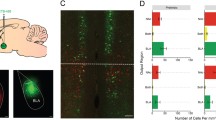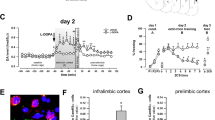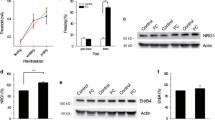Abstract
129S1/SvImJ (S1) mice exhibit selective impairments in fear extinction, though the mechanisms underlying these impairments are not fully understood. The medial prefrontal cortex (mPFC) consists of the prelimbic cortex (PL) and infralimbic cortex (IL), which are known to be involved in fear conditioning and extinction, respectively. The PL and IL project to the basolateral amygdala (BLA) that also plays an important role in both mechanisms. In the present study, we utilized optogenetic and electrophysiological approaches to measure inhibitory/excitatory ratios (I/E ratios) in mPFC-BLA circuits of S1 and control C57BL/6 (B6) mice following fear conditioning and extinction. As suggested previously, PL inputs to the BLA became more excitatory after fear conditioning in B6 mice. S1 mice also exhibited strengthened PL-BLA circuit following fear conditioning. Interestingly, fear extinction restored PL-BLA circuit strength to levels comparable to the baseline in B6 mice. However, PL-BLA circuit strength remained abnormally high even after extinction in S1 mice. The IL-BLA circuit became more inhibitory in B6 mice after fear extinction, whereas extinction failed to change the excitability of the IL-BLA circuit in S1 mice. These data suggest that the fear extinction impairments observed in S1 mice may be due to constantly decreased I/E balance in the PL-BLA circuit and lack of changes in I/E balance in the IL-BLA circuit. This further suggests that investigation of both pathways is instrumental in developing more effective therapeutics for psychopathologies that involve impairments in fear extinction, such as chronic pain and posttraumatic stress disorder.





Similar content being viewed by others
References
Maren S (2001) Neurobiology of Pavlovian fear conditioning. Annu Rev Neurosci 24:897–931. https://doi.org/10.1146/annurev.neuro.24.1.897
Pavlov IP (1927) Conditioned reflexes. Oxford University Press, London
Myers KM, Davis M (2007) Mechanisms of fear extinction. Mol Psychiatry 12(2):120–150. https://doi.org/10.1038/sj.mp.4001939
Wessa M, Flor H (2007) Failure of extinction of fear responses in posttraumatic stress disorder: Evidence from second-order conditioning. Am J Psychiatry 164(11):1684–1692. https://doi.org/10.1176/appi.ajp.2007.07030525
Wicking M, Steiger F, Nees F, Diener SJ, Grimm O, Ruttorf M, Schad LR, Winkelmann T et al (2016) Deficient fear extinction memory in posttraumatic stress disorder. Neurobiol Learn Mem 136:116–126. https://doi.org/10.1016/j.nlm.2016.09.016
Camp M, Norcross M, Whittle N, Feyder M, D'Hanis W, Yilmazer-Hanke D, Singewald N, Holmes A (2009) Impaired Pavlovian fear extinction is a common phenotype across genetic lineages of the 129 inbred mouse strain. Genes Brain Behav 8(8):744–752. https://doi.org/10.1111/j.1601-183X.2009.00519.x
Hefner K, Whittle N, Juhasz J, Norcross M, Karlsson RM, Saksida LM, Bussey TJ, Singewald N et al (2008) Impaired fear extinction learning and cortico-amygdala circuit abnormalities in a common genetic mouse strain. J Neurosci 28(32):8074–8085. https://doi.org/10.1523/JNEUROSCI.4904-07.2008
Wille A, Maurer V, Piatti P, Whittle N, Rieder D, Singewald N, Lusser A (2015) Impaired contextual fear extinction learning is associated with aberrant regulation of CHD-type chromatin remodeling factors. Front Behav Neurosci 9:313. https://doi.org/10.3389/fnbeh.2015.00313
Park K, Chung C (2019) Systemic cellular activation mapping of an extinction-impaired animal model. Front Cell Neurosci 13:99. https://doi.org/10.3389/fncel.2019.00099
Whittle N, Hauschild M, Lubec G, Holmes A, Singewald N (2010) Rescue of impaired fear extinction and normalization of cortico-amygdala circuit dysfunction in a genetic mouse model by dietary zinc restriction. J Neurosci 30(41):13586–13596. https://doi.org/10.1523/JNEUROSCI.0849-10.2010
Corcoran KA, Quirk GJ (2007) Activity in prelimbic cortex is necessary for the expression of learned, but not innate, fears. J Neurosci 27(4):840–844. https://doi.org/10.1523/JNEUROSCI.5327-06.2007
Herry C, Ciocchi S, Senn V, Demmou L, Muller C, Luthi A (2008) Switching on and off fear by distinct neuronal circuits. Nature 454(7204):600–606. https://doi.org/10.1038/nature07166
Quirk GJ, Russo GK, Barron JL, Lebron K (2000) The role of ventromedial prefrontal cortex in the recovery of extinguished fear. J Neurosci 20(16):6225–6231
Burgos-Robles A, Vidal-Gonzalez I, Quirk GJ (2009) Sustained conditioned responses in prelimbic prefrontal neurons are correlated with fear expression and extinction failure. J Neurosci 29(26):8474–8482. https://doi.org/10.1523/JNEUROSCI.0378-09.2009
Do-Monte FH, Manzano-Nieves G, Quinones-Laracuente K, Ramos-Medina L, Quirk GJ (2015) Revisiting the role of infralimbic cortex in fear extinction with optogenetics. J Neurosci 35(8):3607–3615. https://doi.org/10.1523/JNEUROSCI.3137-14.2015
Milad MR, Quirk GJ (2002) Neurons in medial prefrontal cortex signal memory for fear extinction. Nature 420(6911):70–74. https://doi.org/10.1038/nature01138
Vidal-Gonzalez I, Vidal-Gonzalez B, Rauch SL, Quirk GJ (2006) Microstimulation reveals opposing influences of prelimbic and infralimbic cortex on the expression of conditioned fear. Learn Mem 13(6):728–733. https://doi.org/10.1101/lm.306106
Sierra-Mercado D, Padilla-Coreano N, Quirk GJ (2011) Dissociable roles of prelimbic and infralimbic cortices, ventral hippocampus, and basolateral amygdala in the expression and extinction of conditioned fear. Neuropsychopharmacology 36(2):529–538. https://doi.org/10.1038/npp.2010.184
Amano T, Duvarci S, Popa D, Pare D (2011) The fear circuit revisited: Contributions of the basal amygdala nuclei to conditioned fear. J Neurosci 31(43):15481–15489. https://doi.org/10.1523/JNEUROSCI.3410-11.2011
Gale GD, Anagnostaras SG, Godsil BP, Mitchell S, Nozawa T, Sage JR, Wiltgen B, Fanselow MS (2004) Role of the basolateral amygdala in the storage of fear memories across the adult lifetime of rats. J Neurosci 24(15):3810–3815. https://doi.org/10.1523/JNEUROSCI.4100-03.2004
Laurent V, Westbrook RF (2010) Role of the basolateral amygdala in the reinstatement and extinction of fear responses to a previously extinguished conditioned stimulus. Learn Mem 17(2):86–96. https://doi.org/10.1101/lm.1655010
Arruda-Carvalho M, Clem RL (2014) Pathway-selective adjustment of prefrontal-amygdala transmission during fear encoding. J Neurosci 34(47):15601–15609. https://doi.org/10.1523/JNEUROSCI.2664-14.2014
Bukalo O, Pinard CR, Silverstein S, Brehm C, Hartley ND, Whittle N, Colacicco G, Busch E et al (2015) Prefrontal inputs to the amygdala instruct fear extinction memory formation. Sci Adv 1(6). https://doi.org/10.1126/sciadv.1500251
Cho JH, Deisseroth K, Bolshakov VY (2013) Synaptic encoding of fear extinction in mPFC-amygdala circuits. Neuron 80(6):1491–1507. https://doi.org/10.1016/j.neuron.2013.09.025
Likhtik E, Pelletier JG, Paz R, Pare D (2005) Prefrontal control of the amygdala. J Neurosci 25(32):7429–7437. https://doi.org/10.1523/JNEUROSCI.2314-05.2005
Vertes RP (2004) Differential projections of the infralimbic and prelimbic cortex in the rat. Synapse 51(1):32–58. https://doi.org/10.1002/syn.10279
Brinley-Reed M, Mascagni F, McDonald AJ (1995) Synaptology of prefrontal cortical projections to the basolateral amygdala: An electron microscopic study in the rat. Neurosci Lett 202(1–2):45–48. https://doi.org/10.1016/0304-3940(95)12212-5
Coultrap SJ, Bayer KU (2012) CaMKII regulation in information processing and storage. Trends Neurosci 35(10):607–618. https://doi.org/10.1016/j.tins.2012.05.003
Jones EG, Huntley GW, Benson DL (1994) Alpha calcium/calmodulin-dependent protein kinase II selectively expressed in a subpopulation of excitatory neurons in monkey sensory-motor cortex: Comparison with GAD-67 expression. J Neurosci 14(2):611–629
Watakabe A, Ohtsuka M, Kinoshita M, Takaji M, Isa K, Mizukami H, Ozawa K, Isa T et al (2015) Comparative analyses of adeno-associated viral vector serotypes 1, 2, 5, 8 and 9 in marmoset, mouse and macaque cerebral cortex. Neurosci Res 93:144–157. https://doi.org/10.1016/j.neures.2014.09.002
Arruda-Carvalho M, Wu WC, Cummings KA, Clem RL (2017) Optogenetic examination of prefrontal-amygdala synaptic development. J Neurosci 37(11):2976–2985. https://doi.org/10.1523/JNEUROSCI.3097-16.2017
Hubner C, Bosch D, Gall A, Luthi A, Ehrlich I (2014) Ex vivo dissection of optogenetically activated mPFC and hippocampal inputs to neurons in the basolateral amygdala: Implications for fear and emotional memory. Front Behav Neurosci 8:64. https://doi.org/10.3389/fnbeh.2014.00064
Arruda-Carvalho M, Clem RL (2015) Prefrontal-amygdala fear networks come into focus. Front Syst Neurosci 9:145. https://doi.org/10.3389/fnsys.2015.00145
Krabbe S, Grundemann J, Luthi A (2018) Amygdala inhibitory circuits regulate associative fear conditioning. Biol Psychiatry 83(10):800–809. https://doi.org/10.1016/j.biopsych.2017.10.006
Blum S, Hebert AE, Dash PK (2006) A role for the prefrontal cortex in recall of recent and remote memories. Neuroreport 17(3):341–344. https://doi.org/10.1097/01.wnr.0000201509.53750.bc
Stern CA, Gazarini L, Vanvossen AC, Hames MS, Bertoglio LJ (2013) Activity in prelimbic cortex subserves fear memory reconsolidation over time. Learn Mem 21(1):14–20. https://doi.org/10.1101/lm.032631.113
Do-Monte FH, Quinones-Laracuente K, Quirk GJ (2015) A temporal shift in the circuits mediating retrieval of fear memory. Nature 519(7544):460–463. https://doi.org/10.1038/nature14030
Laurent V, Westbrook RF (2009) Inactivation of the infralimbic but not the prelimbic cortex impairs consolidation and retrieval of fear extinction. Learn Mem 16(9):520–529. https://doi.org/10.1101/lm.1474609
Fitzgerald PJ, Whittle N, Flynn SM, Graybeal C, Pinard CR, Gunduz-Cinar O, Kravitz AV, Singewald N et al (2014) Prefrontal single-unit firing associated with deficient extinction in mice. Neurobiol Learn Mem 113:69–81. https://doi.org/10.1016/j.nlm.2013.11.002
Maroun M, Kavushansky A, Holmes A, Wellman C, Motanis H (2012) Enhanced extinction of aversive memories by high-frequency stimulation of the rat infralimbic cortex. PLoS One 7(5):e35853. https://doi.org/10.1371/journal.pone.0035853
Brooks DC, Bouton ME (1993) A retrieval cue for extinction attenuates spontaneous recovery. J Exp Psychol Anim Behav Process 19(1):77–89
Rescorla RA (2004) Spontaneous recovery. Learn Mem 11(5):501–509. https://doi.org/10.1101/lm.77504
Bouton ME (2004) Context and behavioral processes in extinction. Learn Mem 11(5):485–494. https://doi.org/10.1101/lm.78804
Bouton ME, Bolles RC (1979) Role of conditioned contextual stimuli in reinstatement of extinguished fear. J Exp Psychol Anim Behav Process 5(4):368–378
Bouton ME, King DA (1983) Contextual control of the extinction of conditioned fear: Tests for the associative value of the context. J Exp Psychol Anim Behav Process 9(3):248–265
Rescorla RA, Heth CD (1975) Reinstatement of fear to an extinguished conditioned stimulus. J Exp Psychol Anim Behav Process 1(1):88–96
Bouton ME, Westbrook RF, Corcoran KA, Maren S (2006) Contextual and temporal modulation of extinction: Behavioral and biological mechanisms. Biol Psychiatry 60(4):352–360. https://doi.org/10.1016/j.biopsych.2005.12.015
Rescorla RA (2001) Retraining of extinguished Pavlovian stimuli. J Exp Psychol Anim Behav Process 27(2):115–124
Elsenbruch S, Wolf OT (2015) Could stress contribute to pain-related fear in chronic pain? Front Behav Neurosci 9:340. https://doi.org/10.3389/fnbeh.2015.00340
De Peuter S, Van Diest I, Vansteenwegen D, Van den Bergh O, Vlaeyen JW (2011) Understanding fear of pain in chronic pain: Interoceptive fear conditioning as a novel approach. Eur J Pain 15(9):889–894. https://doi.org/10.1016/j.ejpain.2011.03.002
Schneider C, Palomba D, Flor H (2004) Pavlovian conditioning of muscular responses in chronic pain patients: Central and peripheral correlates. Pain 112(3):239–247. https://doi.org/10.1016/j.pain.2004.08.025
Woods MP, Asmundson GJ (2008) Evaluating the efficacy of graded in vivo exposure for the treatment of fear in patients with chronic back pain: A randomized controlled clinical trial. Pain 136(3):271–280. https://doi.org/10.1016/j.pain.2007.06.037
Vlaeyen JW, de Jong J, Geilen M, Heuts PH, van Breukelen G (2001) Graded exposure in vivo in the treatment of pain-related fear: A replicated single-case experimental design in four patients with chronic low back pain. Behav Res Ther 39(2):151–166
Linton SJ, Boersma K, Jansson M, Overmeer T, Lindblom K, Vlaeyen JW (2008) A randomized controlled trial of exposure in vivo for patients with spinal pain reporting fear of work-related activities. Eur J Pain 12(6):722–730. https://doi.org/10.1016/j.ejpain.2007.11.001
Bailey KM, Carleton RN, Vlaeyen JW, Asmundson GJ (2010) Treatments addressing pain-related fear and anxiety in patients with chronic musculoskeletal pain: A preliminary review. Cogn Behav Ther 39(1):46–63. https://doi.org/10.1080/16506070902980711
den Hollander M, de Jong JR, Volders S, Goossens ME, Smeets RJ, Vlaeyen JW (2010) Fear reduction in patients with chronic pain: A learning theory perspective. Expert Rev Neurother 10(11):1733–1745. https://doi.org/10.1586/ern.10.115
Lohnberg JA (2007) A review of outcome studies on cognitive-behavioral therapy for reducing fear-avoidance beliefs among individuals with chronic pain. J Clin Psychol Med Settings 14(2):113–122. https://doi.org/10.1007/s10880-007-9062-y
American Psychiatric Association (2013) Diagnostic and statistical manual of mental disorders (5th ed.). 5th edn.
Kalisch R, Korenfeld E, Stephan KE, Weiskopf N, Seymour B, Dolan RJ (2006) Context-dependent human extinction memory is mediated by a ventromedial prefrontal and hippocampal network. J Neurosci 26(37):9503–9511. https://doi.org/10.1523/JNEUROSCI.2021-06.2006
Phelps EA, Delgado MR, Nearing KI, LeDoux JE (2004) Extinction learning in humans: Role of the amygdala and vmPFC. Neuron 43(6):897–905. https://doi.org/10.1016/j.neuron.2004.08.042
Bremner JD, Staib LH, Kaloupek D, Southwick SM, Soufer R, Charney DS (1999) Neural correlates of exposure to traumatic pictures and sound in Vietnam combat veterans with and without posttraumatic stress disorder: A positron emission tomography study. Biol Psychiatry 45(7):806–816
Semple WE, Goyer PF, McCormick R, Compton-Toth B, Morris E, Donovan B, Muswick G, Nelson D et al (1996) Attention and regional cerebral blood flow in posttraumatic stress disorder patients with substance abuse histories. Psychiatry Res 67(1):17–28
Shin LM, McNally RJ, Kosslyn SM, Thompson WL, Rauch SL, Alpert NM, Metzger LJ, Lasko NB et al (1999) Regional cerebral blood flow during script-driven imagery in childhood sexual abuse-related PTSD: A PET investigation. Am J Psychiatry 156(4):575–584. https://doi.org/10.1176/ajp.156.4.575
Dunsmoor JE, Bandettini PA, Knight DC (2008) Neural correlates of unconditioned response diminution during Pavlovian conditioning. NeuroImage 40(2):811–817. https://doi.org/10.1016/j.neuroimage.2007.11.042
Knight DC, Waters NS, King MK, Bandettini PA (2010) Learning-related diminution of unconditioned SCR and fMRI signal responses. NeuroImage 49(1):843–848. https://doi.org/10.1016/j.neuroimage.2009.07.012
Linnman C, Rougemont-Bucking A, Beucke JC, Zeffiro TA, Milad MR (2011) Unconditioned responses and functional fear networks in human classical conditioning. Behav Brain Res 221(1):237–245. https://doi.org/10.1016/j.bbr.2011.02.045
Milad MR, Quirk GJ, Pitman RK, Orr SP, Fischl B, Rauch SL (2007) A role for the human dorsal anterior cingulate cortex in fear expression. Biol Psychiatry 62(10):1191–1194. https://doi.org/10.1016/j.biopsych.2007.04.032
Koenigs M, Grafman J (2009) Posttraumatic stress disorder: The role of medial prefrontal cortex and amygdala. Neuroscientist 15(5):540–548. https://doi.org/10.1177/1073858409333072
Acknowledgements
We thank all the members of the Chung lab for discussion and helpful comments.
Funding
This study was supported by Konkuk University in 2016.
Author information
Authors and Affiliations
Contributions
C.C. conceived this work and designed the experiments. K.P. performed the experiments and acquired the data. K.P. and C.C. analyzed and interpreted the data. C.C. and K.P. prepared the manuscript. All authors have approved the final version of the manuscript.
Corresponding author
Ethics declarations
Conflict of Interest
The authors declare that they have no conflict of interest.
Ethical Approval
All applicable international, national, and/or institutional guidelines for the care and use of animals were followed. All procedures performed in studies involving animals were in accordance with the ethical standards of the institution or practice at which the studies were conducted (Institutional Animal Care and Use Committee of Konkuk University, Seoul, Korea). This article does not contain any studies with human participants performed by any of the authors.
Additional information
Publisher’s Note
Springer Nature remains neutral with regard to jurisdictional claims in published maps and institutional affiliations.
Rights and permissions
About this article
Cite this article
Park, K., Chung, C. Differential Alterations in Cortico-Amygdala Circuitry in Mice with Impaired Fear Extinction. Mol Neurobiol 57, 710–721 (2020). https://doi.org/10.1007/s12035-019-01741-3
Received:
Accepted:
Published:
Issue Date:
DOI: https://doi.org/10.1007/s12035-019-01741-3




